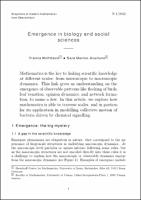| dc.contributor.author | Hoffmann, Franca | |
| dc.contributor.author | Merino-Aceituno, Sara | |
| dc.contributor.editor | Munday, Sara | |
| dc.contributor.editor | Randecker, Anja | |
| dc.date.accessioned | 2022-03-31T08:35:36Z | |
| dc.date.available | 2022-03-31T08:35:36Z | |
| dc.date.issued | 2022-03-31 | |
| dc.identifier.uri | http://publications.mfo.de/handle/mfo/3931 | |
| dc.description.abstract | Mathematics is the key to linking scientific knowledge at different scales: from microscopic to macroscopic dynamics. This link gives us understanding on the emergence of observable patterns like flocking of birds, leaf venation, opinion dynamics, and network formation, to name a few. In this article, we explore how mathematics is able to traverse scales, and in particular its application in modelling collective motion of bacteria driven by chemical signalling. | en_US |
| dc.language.iso | en | en_US |
| dc.publisher | Mathematisches Forschungsinstitut Oberwolfach | en_US |
| dc.relation.ispartofseries | Snapshots of modern mathematics from Oberwolfach;2022-01 | |
| dc.rights | Attribution 4.0 International | * |
| dc.rights.uri | http://creativecommons.org/licenses/by-sa/4.0/ | * |
| dc.title | Emergence in biology and social sciences | en_US |
| dc.type | Article | en_US |
| dc.identifier.doi | 10.14760/SNAP-2022-001-EN | |
| local.series.id | SNAP-2022-001-EN | en_US |
| local.subject.snapshot | Analysis | en_US |
| dc.identifier.urn | urn:nbn:de:101:1-2022112209171771327686 | |
| dc.identifier.ppn | 1823153747 | |


